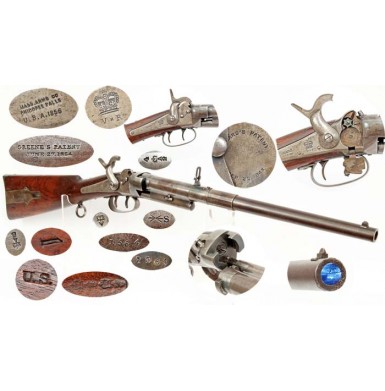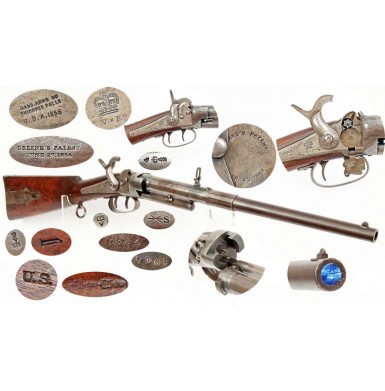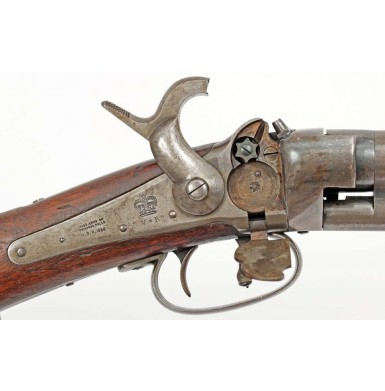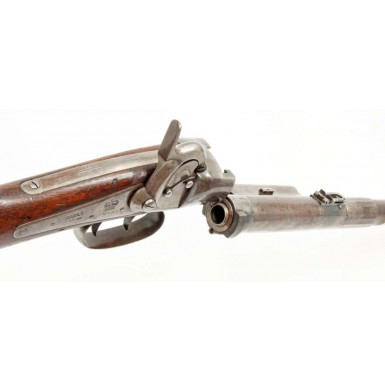Greene Carbine - British Contract & US Surcharged
- Product Code: FLA-2150-SOLD
- Availability: Out Of Stock
-
$1.00
The Greene Patent Breech Loading Carbine has always been a somewhat enigmatic firearm to the US military arms colleting community. The gun was produced in very limited numbers and almost all of the documented production went to fill a British government contract, making extant examples rather scarce in the United States. Lt. Colonel James D. Greene of Cambridge, MA developed the Greene breechloading carbine. Greene was a Harvard graduate, but it is not clear if the rank he always attributed to himself was held in the US army, a local militia, or simply a period marketing tool, not unlike Samuel Colt referring to himself as “Colonel Colt”. Greene patented the designs he would incorporate into the carbine on June 27, 1854, receiving US Patent #11,157. In November of the same year, Greene would also patent a breechloading rifle design, receiving US Patent #11,917. This patent covered what would eventually be known as the Greene Rifle, the first bolt-action rifle to be issued by the US military. Greene’s carbine patent was rather unique in a number of ways. The design revolved around a hinged breech system that was locked by a rotating barrel with two massive lugs opposed 180 degrees from each other. A 2nd trigger, forward of the one that fired the gun, retracted the breech mechanism locking pin when it was depressed. This allowed the user to rotate the breech and barrel section of the carbine 90 degrees in a counter-clockwise (anti-clockwise to the British) direction, and unlock the two large lugs from the frame recesses they engaged. The hinged breech and barrel assembly could then be pushed forward and swung open to the right by 90 degrees, exposing the chamber to load a cartridge. When the nitrated paper or linen cartridge was loaded, the barrel section was then swung back to the left, pulled to the rear and rotated clockwise to lock it. While the process sounds somewhat complicated, it was actually rather simple to do and the action worked smoothly. When the barrel section was pulled back to seat against the receiver of the carbine, a pointed, hollow extension from the breech face punctured the cartridge and made sure that the spark from the primer flash was communicated directly into the power in the cartridge. The carbine also utilized the newly adopted Maynard patent tape priming mechanism. This mechanical priming system, developed by Dr. Edward Maynard, used a varnished paper roll of priming pellets, much like a modern roll of caps used in a child’s cap gun. The system advanced the roll every time the hammer was cocked, placing a fresh primer pellet over the cone (nipple). A sharp cutting edge on the bottom face of the hammer cut off the spent piece of priming tape when the hammer fell. This system was adopted by the US military for their rifles and rifle muskets in 1855, and was also used by the Mass Arms Company in the production of the 1st Model Maynard rifles and carbines, as well as by the Sharps Firearms Company on certain models. On Christmas Eve, 1854, Greene demonstrated his breechloading carbine for the US Ordnance Department board that had been established to research and make recommendations on breech loading arms. The carbine received mixed reviews from the board, but the overall reaction was sufficiently positive that on May 23, 1855 Greene received an order to deliver 200 of his carbines for additional testing. These guns were brass-mounted arms with blued receivers and 22” long, .54 browned barrels. Greene arranged for the manufacture of the guns by the Massachusetts Arms Company, who also produced the Maynard patent carbine and Adams British patent revolvers on license from Robert Adams. The guns were delivered during March of 1856 and saw field service and testing during 1857 and 1858 and again received mixed reviews, although this time the issues were considered significant enough that no further orders were placed and the carbines were withdrawn from service, in favor of more successful designs, like the Sharps. Greene additionally sought out foreign military contracts for his design, while at the same time courting the US Ordnance Department. He managed to secure a British contract for 2,000 of his carbines, theoretically for service in the Crimean War (October 1853-February 1856), but did not deliver the arms until after the war was over. More than likely his association with the Massachusetts Arms Company, and their close relationship with British Arms industry through Robert Adams and the London Armoury Company, smoothed the way for a little “quid pro quo”, allowing Mass Arms to sell some of their merchandise to the British military. Much like the British contract P-1853 Enfield rifle muskets, the British provided viewers in America to inspect and mark the Greene carbines during production. The Greene carbines produced for British service were slightly different from the American version. The carbines were iron mounted instead of brass mounted, and had slightly shorter barrels at 18” in length instead of 22”. According to noted 19thcentury arms researchers and authors John McAuley and Dr. C.H. Rhoads, the British contract Greene carbines were not delivered until 1858, well after the cessation of Crimean conflict, so they clearly never saw service there. Rhoads notes that the carbines were placed in storage while an attempt was made to develop suitable ammunition for use in them. With the War Department’s adoption of the British made Calisher & Terry and Westley Richards breechloading carbines, the Greene’s remained in mothballs in England. According to a January 1, 1862 War Department ordnance report, 1,960 of the 2,000 Greene’s remained in storage. It is assumed that those 40 arms were used for testing, but it is possible that some of them were sold from service as well. In March of 1862 additional attempts were made to find an appropriate cartridge for the carbine, in order to issue them to the Cape Mounted Rifles, but no significant improvements in design were noted until 1865, at which point the attempt to find suitable ammunition was abandoned. According to Dr. Rhoads research, the majority of the British contract Greene carbines were destroyed, with only some 200 total being sold out of service. For many decades it has been argued that at least a handful of British contract Greene carbines were returned to the United States during the Civil War and saw use. On the surface, and based upon Rhoads research this seems improbable, but a handful of US surcharged British pattern Greene carbines are known to exist. These guns inevitably show the opposed Broad Arrows and “S’ “sold out of service” mark of items sold as surplus by the British military. They also bear a “US’ surcharge on either their locks, buttplates or buttstocks. This suggests that somehow, at least some of the British Greene’s did return for Civil War duty. It appears most likely that they would have been sold to one of the large international arms speculators like Schuyler, Hartley & Graham or Herman Boker, who would have them sold them to the US government or northern states. Although the Greene carbine is not listed specifically in Document 99, which lists all US Ordnance Department arms purchases during the course of the American Civil War, the Greene’s may actually be hiding within the deliveries of foreign arms, but simply not listed by name. Some of the foreign arms purchase entries that might account for Greene carbines include the following:
Herman Boker - 188 Rifled Arms @ $15.00 each.
Howland & Aspinwall “ 50 Carbines @ $22.00.
Samuel Smith “ 391 Carbines @ $25.00 each.
In each case, these unidentified arms might be surplus Greene’s, with the 50 carbines sold by Howland & Aspinwall at $22.00 each being very likely culprits. The number of arms nearly coincides with the 40 guns missing from British stores by January of 1862, and the price clearly indicates a breechloading weapon of high quality. While we may never know for sure, it does appear possible that at least a handful of the British Greene’s may have been repatriated to the US to see service in the American Civil War.
This British Contract Greene Carbine is one of the very scarce and desirable examples that bears a US surcharge on it. The gun is in about VERY GOOD+ to NEAR FINE condition and is 100% complete, correct and original in every way. The lock of the gun is clearly marked in three vertical lines behind the hammer: MASS. ARMS CO / CHICOPEE FALLS / U.S.A. 1856. The two line gang die that stamped the top two lines skipped when it was stuck, as the mark has a “shadowed” look to it, due to the die stuttering. The lock is also clearly marked with a (BRITISH CROWN) / V x R. The tape primer door is marked in two arced lines: MAYNARD’s PATENT / CER. SEP. 22 . 1845. The tang of the carbine is crisply marked in two lines: GREENE’s PATENT / JUNE 27, 1854. The bottom of flat of the 16-sided grasping portion of the barrel is marked with the serial number 1564, and this same number appears on the bottom of one of the frame lugs and on one of the barrel locking lugs. A myriad of British inspection marks appear in the metal of the carbine, on the top of the barrel, top of the receiver, patch box, etc. These include both (CROWN) / A / 2 and (CROWN) / A / 5 marks. The “crown” indicating British military inspectors, the “A” indicating “America” and the number being that of the individual inspector. A small “Crowned Broad Arrow” appears on the top flat of the 16-sided grasping portion of the barrel, directly in front of the rear sight, and behind the triggerguard. A (CROWN) / A / 6 mark is present in the wood behind the triggerguard tang. The left side of the breech is marked with the British military sold out of service surplus mark of two opposed Broad Arrows and a single capital S. The obverse buttstock bears a British War Department storekeepers mark, a single 1, just forward of the patchbox. On a rifle musket this would indicate "1st Quality", in other words, a machine made, interchangeable parts gun. I would guess it has the same meaning in this case. The most interesting mark is the simple US surcharge of U.S. stamped at the upper right hand corner of the reverse buttstock, near the buttplate. This same mark is known on a handful of Greene carbines and suggests US military service, after the gun was sold from British stores, likely during 1861. As noted, the carbine remains in VERY GOOD+ to NEAR FINE condition. The cased hardened lock retains about 30% original faded case coloring with some darker mottling present. The lock remains crisp and tight and is fully functional in all respects, with the Maynard system working perfectly. Breechloading action and locking mechanism of the carbine function perfectly as well and the carbine opens smoothly and locks up securely as it should. The receiver of the carbine retains about 10%-20% of its original blued finish that has faded and blended with a smoky gray patina. The blue is more vivid and more evident in the protected areas of the receiver and inside the action of the carbine. The receiver is mostly smooth and free of any pitting, with only some scattered patches of light surface oxidation present. The barrel of the carbine has a thick, brown, oxidized patina, which is untouched and uncleaned. The barrel shows light pitting around the 16-sided gripping area and scattered along the entire barrel. This is mixed with evenly distributed pinpricking over the entire barrel. The bore of the carbine is in about VERY GOOD+ to NEAR FINE condition. The bore is mostly bright, with crisp rifling throughout. The bore shows only lightly scattered pitting along its length, with a couple of more moderate patches of roughness nearer to the muzzle. The carbine retains both its original long-range rear sight and the original font sight. The carbine also retains its original carbine sling ring, mounted behind the triggerguard tang. The ring remains secure and swivels freely as it should. The wood of the carbine’s buttstock rates about VERY GOOD+ to NEAR FINE. It is crisply marked with a U.S. on the reverse, near the upper rear edge of the butt. The wood is solid and complete without any breaks, cracks or repairs. As would be expected, the wood shows numerous bumps, dings and minor mars from handling, use and storage over the years.
Overall this is a really attractive example of a very scarce British Contract Greene Carbine. These guns are rarely found for sale and according to researchers very few even survived the mid-19th century. With most estimates at only 200 of the 2,000 manufactured having been sold as complete arms, it is understandable why they are very difficult to find some 150 years later. While it seems improbable that more than a handful ever left British service to see use during the Civil War, it is clearly possible that a few did. The small number of extant examples with US surcharges, combined with the known fact that at least 40 were missing from stores by January 1 of 1862, makes for some intriguing possibilities. When combined with some of the less than detailed listings of foreign arms purchases, it is possible to see how a few ended up in US service without ever being listed as purchased. What makes this even more likely is the fact that according to researchers Whisker, Yantz & Hartzler (see US Civil War Carbines), Company C of the 6th Ohio Volunteer Cavalry was armed exclusively with Greene patent carbines, according to their February 1, 1863 ordnance returns. As it is unlikely that they would have been carrying the American made Greene’s discounted by the US Ordnance Department in 1858, they almost certainly were armed with the British made variants. No matter what the explanation, at least a few Greene carbines do appear to have made it back to American soil. These are really rare guns that deserve a place in an advanced 19th century small arms and carbine collection, and this one displays nicely and has that coveted “US’ mark.
SOLD







